After more than 550 posts over the course of two years and eight months, I just didn’t get it done this week. Sorry. There was no particular reason. We’ll pick up again on Thursday with more state wildlife research news.
Author Archives: MadelineBodin
Fishers Not Found in Wyoming
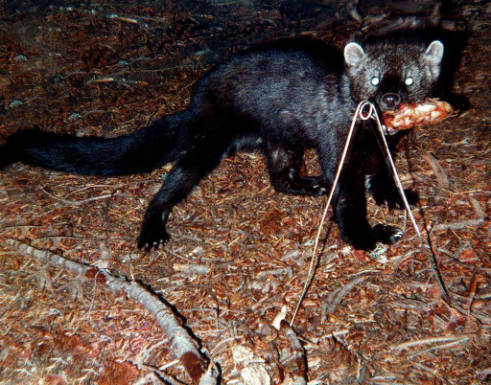 Habitat models say that there should be fishers in the Wyoming section of the Northern Rocky Mountains, says the Billings Gazette, but a search by the Wyoming Game and Fish Department of the Sunlight Basin, near the Beartooth Mountains, just to the east of Yellowstone National Park did not turn up any fishers.
Habitat models say that there should be fishers in the Wyoming section of the Northern Rocky Mountains, says the Billings Gazette, but a search by the Wyoming Game and Fish Department of the Sunlight Basin, near the Beartooth Mountains, just to the east of Yellowstone National Park did not turn up any fishers.
“We didn’t find any (fishers),” the Billings Gazette article quotes Game and Fish nongame biologist Bob Oakleaf as saying. “What we did find is (pine) marten everywhere.”
It has been about 10 years since the last fisher sighting in the state, the article notes. The Northern Rockies population of fishers had been rejected for listing under the federal Endangered Species Act. Further searches for the fisher will be conducted next year.
More details about the search, and the history of fishers in Wyoming, are available in the article. Read it on the Billings Gazette website, here.
Photo: Fisher taking bait in Pacific Northwest. Courtesy US Fish and Wildlife Service.
Newly Discovered Chytrid Fungus
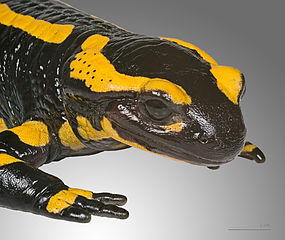 A new species of chytrid fungus has a different ecological niche than the one that has been wiping out amphibians all over the globe, says John Platt it Scientific American’s Extinction Countdown blog.
A new species of chytrid fungus has a different ecological niche than the one that has been wiping out amphibians all over the globe, says John Platt it Scientific American’s Extinction Countdown blog.
The familiar strain of chytrid fungus thrived in warmer temperatures. The newly discovered species thrives at lower temperatures, the blog post says. The fungus was identified in salamanders in the Netherlands. Midwife toads exposed to the fungus in the lab did not die.
Is this good news or bad news? It could be good news if the fungus is only lethal to a small number of species and is only viable in a certain temperature range. Limits are good when it comes to chytrid fungi.
However, if this species of chytrid fungus is totally different from the other species that has already done a good job of wiping out amphibians worldwide in everything but how lethal it is — in could just hit amphibian species and environments that the other species hasn’t gotten to yet, which would be very bad news indeed.
Read the Extinction Countdown blog post here.
Read the Proceedings of the National Academy of Sciences paper here. (Fee or subscription required for full article.)
Photo: Fire salamander in France, by Didier Descouens. Used under Creative Commons agreement.
Chytrid Fungus Found in Kansas
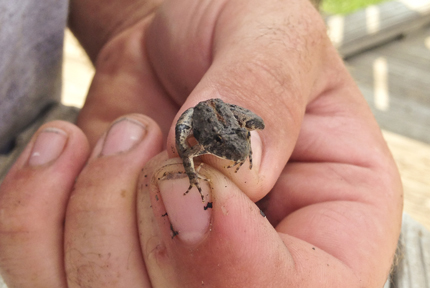 A press release from Wichita State University says that students there have detected chytrid fungus in the frogs they tested. A previous test of five Kansas frogs did not detect chytrid fungus.
A press release from Wichita State University says that students there have detected chytrid fungus in the frogs they tested. A previous test of five Kansas frogs did not detect chytrid fungus.
Read the Wichita State press release, here.
Pro-MED has lots of helpful technical details about chytrid fungus in its commentary about the press release, including its complex life cycle and its role in the worldwide decline of amphibians.
Read the Pro-MED comment, here.
In reading that chytrid fungus was newly found in Kansas, I found myself wishing for a map of its presence, as is available for white nose syndrome in bats and chronic wasting disease in deer. You can find that map right here.
Photo: One of the frogs tested. By: Lainie Rusco, used courtesy of Wichita State University
Wildlife and Infrastructure
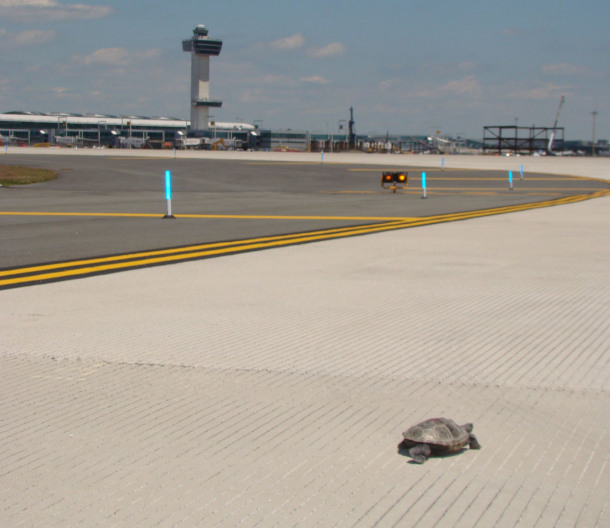 Sure, you know all about roads and wildlife, but roads are not the only place that wildlife and human infrastructure can do bad things to each other. Two recent stories point out some of the more unusual ways that wildlife influences modern life, and how our modern structures influence the survival of wildlife. (Although that sounds so serious. One of these stories is “cute,” and the other has been mostly reported as “cute.”)
Sure, you know all about roads and wildlife, but roads are not the only place that wildlife and human infrastructure can do bad things to each other. Two recent stories point out some of the more unusual ways that wildlife influences modern life, and how our modern structures influence the survival of wildlife. (Although that sounds so serious. One of these stories is “cute,” and the other has been mostly reported as “cute.”)
New York City’s Kennedy Airport is on the shores of Jamaica Bay, which is an estuary off the Atlantic Ocean. In addition to the airport, the bay is also home to the National Park Service’s Jamaica Bay Wildlife Refuge. This creates all sorts of interesting interactions between airplanes and wildlife, but the story of the last two years has been that diamond terrapins, an aquatic turtle, have been crawling across the airport’s runways in search of nesting sites.
Read the whole story in the US Fish and Wildlife Service’s Northeastern Region blog, here.
New York Times Magazine contributor Jon Mooallem has been tracking P.O.C.B.S. — power outages caused by squirrels. He writes about it in the New York Times opinion section. There are many serious potential take-aways in this humorous story, one of which is that no one really knows how many power outages each year are caused by squirrels, or other wildlife.
Read the story in the New York Times, here.
Photo: Yes, that’s a diamondback terrapin crossing a taxiway at John F. Kennedy International Airport. Credit: Port Authority of NY & NJ
What is National Wildlife Day?
Today, September 4, is National Wildlife Day. I had never heard of it before, but a Nature Conservancy newsletter that arrived today happened to mention it. It’s been around since 2006.
According to the National Wildlife Day website, the day is brought to us by the Animal Miracle Network. And if you have never heard of that either, that’s because it’s a pet rescue organization. (I could not find any media on any of this that was not a rehash of a press release, or just a press release.)
Again, according to the website, animal advocate Colleen Paige, founder of the Animal Miracle Network, created the day in 2006 to honor Animal Planet star Steve Irwin and the zoos and animal sanctuaries that preserve endangered wildlife and educate the public about their plight.
The website says that National Wildlife Day aims to focus attention on the endangered animals that need to be preserved and rescued. (I would just quote the sentence from the website, but the website denies that use without prior permission, even though it would be “fair use,” under copyright law.) So you can kind of see the train of thought here: rescuing cats and dogs, rescuing wildlife.
Don’t get me wrong, I love zoos, respect their work, and honor the way they allow people to connect with animals. But if this is the point, how about calling it National Zoo Day?
A day devoted to the idea that keeping endangered wildlife captive is a way to protect it is worrisome. This, of course, is just one tool, and a last-ditch one, in a very large toolbox. It feels like the guiding spirit here is the pet-ification of wildlife (my clues are the photos of the founder hugging a wolf and kissing a bear), although it may be simply retro, or even deliberately choosing to focus on this tiny piece of the conservation puzzle even though it’s not the dominant technique.
National Wildlife Day is doing its best to control the message that goes out under its name, which is really too bad. Who can argue against a day to recognize wildlife, except, as is the case, if it focuses on one tiny aspect of wildlife — endangered species — and just one of many techniques for helping those species. As far as I know, it’s not an official day, of the sort recognized by Congress or a state legislature.
In fact, National Wildlife Day didn’t make the “Days of the Year” website (which is just a random website, and is also not official), but the much more mainstream Endangered Species Day (May 16, 2014 — mark your calendars) did.
Getting the Lead Out
 Two stories today focus on two different states’ efforts to get lead out of the environment.
Two stories today focus on two different states’ efforts to get lead out of the environment.
An article in the Portland (Maine) Herald Press literally goes behind the scenes of the recent legislative ban on lead fishing gear in Maine, which was passed earlier this year, but won’t totally ban the lead gear until 2017. It goes into the lab of Mark Pokras, a Tufts University professor of wildlife health, who played a role in encouraging that legislation. Pokras has been studying lead poisoning in loons for over 20 years.
Pokras says that lead poisoning is responsible for the deaths of over a third of the loons that find their way to his lab in Massachusetts.
Read the story in the Portland Herald Press, here.
In Minnesota, studies show that a bad shot with a lead bullet (such as one that hits a hip bone), can cause lead to splinter throughout a white tailed deer’s flesh to the extent that it would be difficult, or impossible, to remove all of it. For the sake of public health, and also for the sake of the state’s bald eagles, the Minnesota Department of Natural Resources encourages deer hunters to voluntarily use copper bullets.
The article details some of the differences between hunting with copper and lead bullets, which implies that a different technique may be more effective when using copper bullets.
Read the story in the Minnesota Conservation Volunteer, here.
Tick, Tick, Tick, Moose
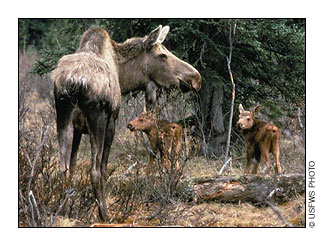 From a New Hampshire Fish and Game press release:
From a New Hampshire Fish and Game press release:
New Hampshire Fish and Game is partnering with the University of New Hampshire in a major new research effort to learn more about the causes of moose mortality and how our changing weather patterns may be affecting both the causes and rates of mortality in our moose herd. Funded entirely by federal Wildlife Restoration dollars, this project updates and enhances the research we did from 2001-2006.
Over a two-year period, we will place radio collars on 80-90 adult moose cows and calves. A helicopter wildlife crew will capture and collar the animals. We will track the collared animals for four years, monitoring them for as long as the collars keep transmitting. We’ll be looking at how long the individuals live; and when they die, we’ll try to get there as soon as possible to determine cause of death. This research will help us determine what the mortality rate and causes are at this time. It seems to have increased since our last mortality research project. We want to know if mortality is being caused by winter tick or other factors. These answers will inform future management decisions.
Read the rest of the release, which mostly addresses the impact of winter tick mortality on New Hampshire’s moose population (the point being that the population has suffered, but it’s not about to disappear) here. It is in the form of a Q&A with award-winning moose biologist Kristine Rines.
NH Fish and Game winter tick press release/Q&A
Photo: A moose and calves from the NH Fish and Game press release, however, the name of the file indicates that it came from the US Fish and Wildlife Service.
Wild Pig Conference – April 2014
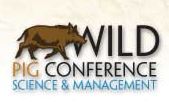 From the conference website:
From the conference website:
Damage caused by wild pigs is one of the greatest concerns to wildlife biologists and managers today. Wild pigs have the potential to cause ecological and economical destruction far surpassing any other invasive exotic vertebrate. The International Wild Pig Conference provides federal, state, and private stakeholders a venue to discuss biological, financial, and social implications specific to wild pig subsistence in our ecosystems.
The conference will be held at the Embassy Suites Hotel and Conference Center on April 14 – 16, 2014.
For more information, including registration and a call for papers, visit the conference website, here.
Bears: Attacks and Responses
 A black bear attack on a 12-year-old girl in Michigan made national news last week. However, a Michigan Department of Natural Resources press release says that a bear killed by DNR personnel shortly after the attack was not the bear in the attack. The bear was not killed because of any possible connection to the attack, but because it had been wounded by being shot by a home-owner who feared for his life.
A black bear attack on a 12-year-old girl in Michigan made national news last week. However, a Michigan Department of Natural Resources press release says that a bear killed by DNR personnel shortly after the attack was not the bear in the attack. The bear was not killed because of any possible connection to the attack, but because it had been wounded by being shot by a home-owner who feared for his life.
The release says that DNA analysis shows that the bear that attacked the girl was female, while the bear that was killed was male.
Read the Michigan DNR press release here.
And if you haven’t seen the bear attack coverage, you can find some of it here.
NBC Nightly News notes that it was a busy week for bear attacks.
In Idaho, in a situation that closely echos the Michigan incident, the US Fish and Wildlife Service is investigating the shooting of a grizzly bear on private property to see if the bear is the same one that attacked two biologists earlier in the month, Reuters reports.
Read the Reuters story here.
Another Reuters story contains a single paragraph about the biologists, which is the most information I could find anywhere. Read the whole story in the Willmar, Minn. West Central Tribune:
Also on Thursday, Idaho wildlife officials reported that two biologists collecting grizzly habitat data in the eastern part of the state were knocked down by a charging grizzly after they startled it. Spray was used to scare off the bear, which bit one man on the backside and the other on the hands.
Photo: This is my generic black bear photo, courtesy US Fish and Wildlife Service. This bear has neither attacked a human nor been shot, to the best of my knowledge.
